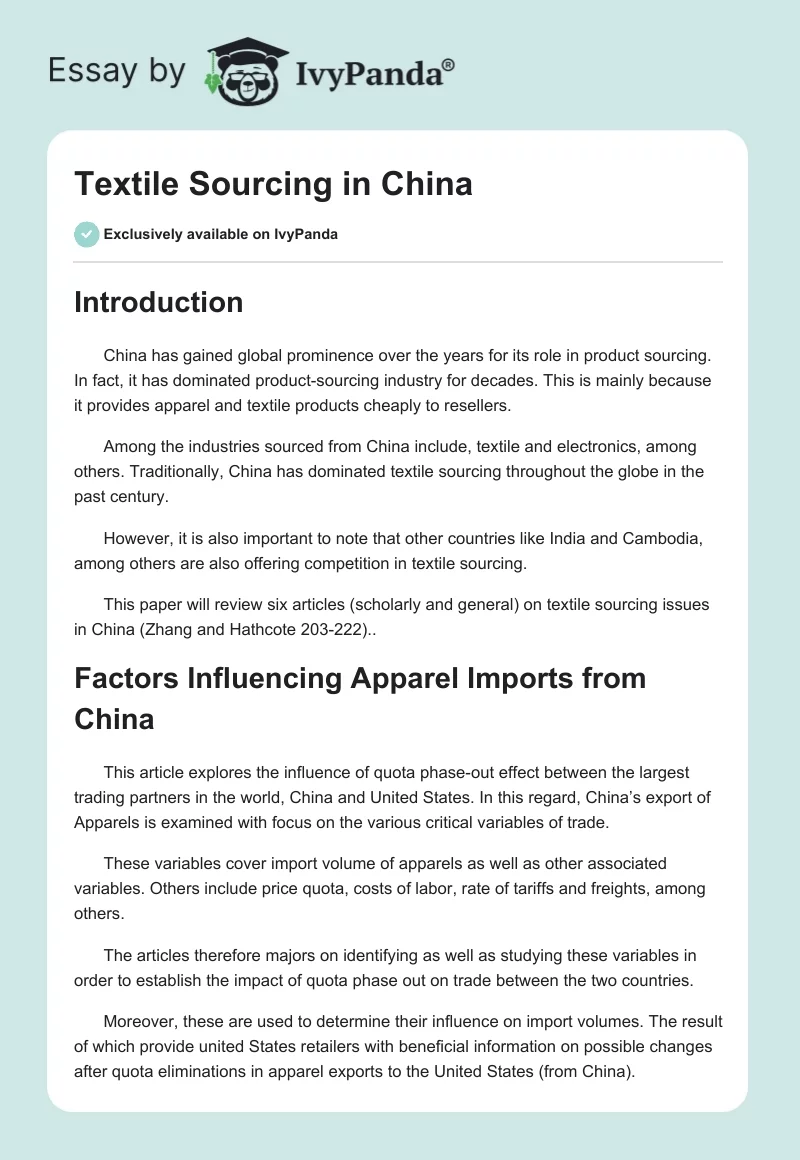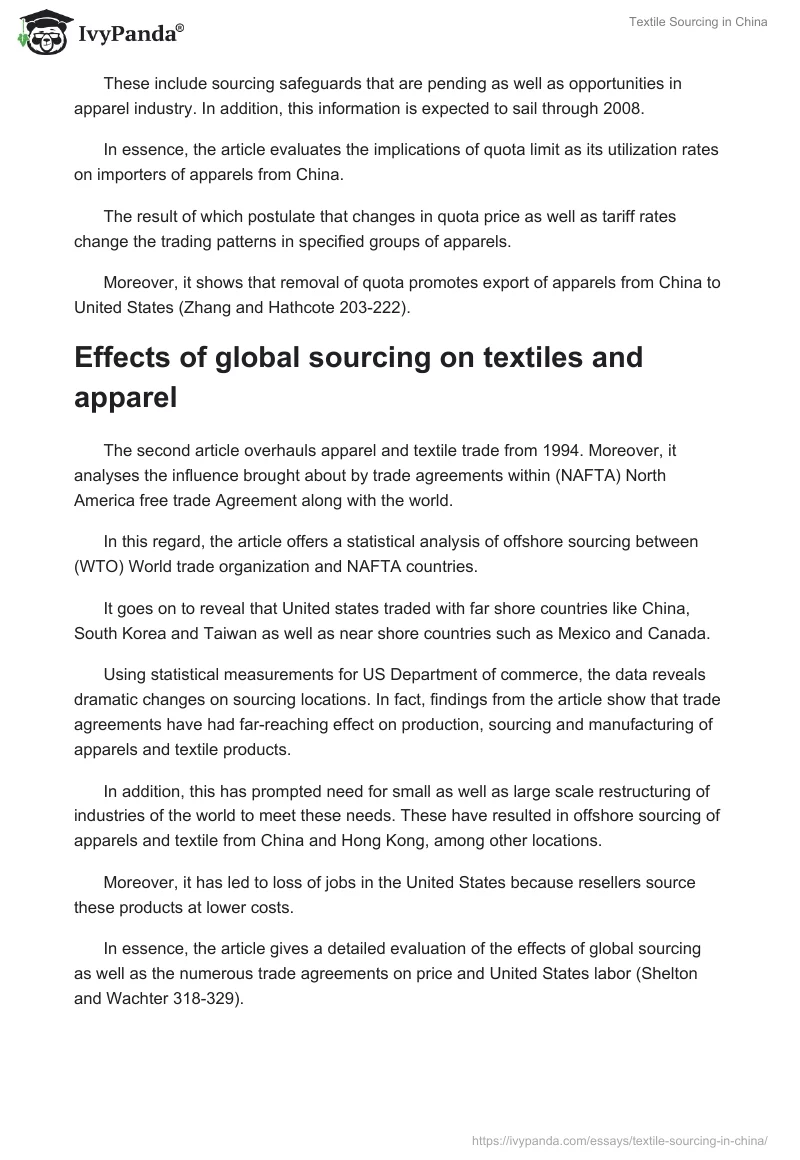- Introduction
- Factors Influencing Apparel Imports from China
- Effects of global sourcing on textiles and apparel
- What is happening in China’s Textile and Clothing Industries?
- Where Made-in-China Textiles Are Emigrating
- Chinese clothing makers see order losses through 2012
- Sourcing Right from China
- Conclusion
- Works Cited
Introduction
China has gained global prominence over the years for its role in product sourcing. In fact, it has dominated product-sourcing industry for decades. This is mainly because it provides apparel and textile products cheaply to resellers.
Among the industries sourced from China include, textile and electronics, among others. Traditionally, China has dominated textile sourcing throughout the globe in the past century.
However, it is also important to note that other countries like India and Cambodia, among others are also offering competition in textile sourcing.
This paper will review six articles (scholarly and general) on textile sourcing issues in China (Zhang and Hathcote 203-222)..
Factors Influencing Apparel Imports from China
This article explores the influence of quota phase-out effect between the largest trading partners in the world, China and United States. In this regard, China’s export of Apparels is examined with focus on the various critical variables of trade.
These variables cover import volume of apparels as well as other associated variables. Others include price quota, costs of labor, rate of tariffs and freights, among others.
The articles therefore majors on identifying as well as studying these variables in order to establish the impact of quota phase out on trade between the two countries.
Moreover, these are used to determine their influence on import volumes. The result of which provide united States retailers with beneficial information on possible changes after quota eliminations in apparel exports to the United States (from China).
These include sourcing safeguards that are pending as well as opportunities in apparel industry. In addition, this information is expected to sail through 2008.
In essence, the article evaluates the implications of quota limit as its utilization rates on importers of apparels from China.
The result of which postulate that changes in quota price as well as tariff rates change the trading patterns in specified groups of apparels.
Moreover, it shows that removal of quota promotes export of apparels from China to United States (Zhang and Hathcote 203-222).
Effects of global sourcing on textiles and apparel
The second article overhauls apparel and textile trade from 1994. Moreover, it analyses the influence brought about by trade agreements within (NAFTA) North America free trade Agreement along with the world.
In this regard, the article offers a statistical analysis of offshore sourcing between (WTO) World trade organization and NAFTA countries.
It goes on to reveal that United states traded with far shore countries like China, South Korea and Taiwan as well as near shore countries such as Mexico and Canada.
Using statistical measurements for US Department of commerce, the data reveals dramatic changes on sourcing locations. In fact, findings from the article show that trade agreements have had far-reaching effect on production, sourcing and manufacturing of apparels and textile products.
In addition, this has prompted need for small as well as large scale restructuring of industries of the world to meet these needs. These have resulted in offshore sourcing of apparels and textile from China and Hong Kong, among other locations.
Moreover, it has led to loss of jobs in the United States because resellers source these products at lower costs.
In essence, the article gives a detailed evaluation of the effects of global sourcing as well as the numerous trade agreements on price and United States labor (Shelton and Wachter 318-329).
What is happening in China’s Textile and Clothing Industries?
The third article focuses on pronounced changes observable in China’s textile industry. In addition, it studies elimination of quota and its resultant effect on export of textile and clothing products.
Moreover, the article explores the prevailing issues surrounding textile industry in China. Furthermore, it goes on to explore the understanding that prevails between China and western countries.
To achieve this, the article conducted fourteen in depth interviews on the same. From these, four themes arose.
These include transformation of China textile industry into a market economic system from a planned economic system as well as the transition of different formats of clothing and textile industries through varying processes.
Others include location of most clothing and textile industries along China’s east coast region and the three main challenges the industries face (increasing price of energy, unpredictability of trading environment and the ever-shifting currency exchange rates).
This has led to a shift in strategies to curb the changes. Among the strategies developed, include emphasis on quality as opposed to quantity and the introduction of Chinese brands.
Other strategies include moving of facilities with the aim of minimizing cost of production, in essence, the article gives a broad and in depth analysis of the changes in China’s textile industries (Shen 23-40).
Where Made-in-China Textiles Are Emigrating
The fourth article talks of migration of Chinese textile industries to other countries with the hope of minimizing costs of production. It gives an example of Cambodia where factories are already settling with the aim of increasing production.
Moreover, the clothes made are designated for sale in United States and Europe. This shows the current trend in manufacturing pattern as attention shifts to other counties with cheap labor.
In essence, it can be noted that the fundamentals of trade remains the same but locations of productions change. In fact, this change is only aimed at retaining the fundamentals of using the least possible cost of manufacturing.
The article goes on to give an example of companies aiming to expand their production in Cambodia. These include Top foam, among others.
The article attributes this change to increased cost of production in China as well as the high employee turnover that affects productivity.
Other countries in which diversification of Chinese industries are targeting include Bangladesh, Indonesia and Vietnam, among others. The article also provides statistical data to prove this change.
For instance, China’s apparel export shrank from 43.6% (2010) to 36.65% as per the fist half estimates in 2011.
However, the challenges that stile strike these new players lie on infrastructure development. In essence, the article explores the possibility of shifting Chinese textile industry to other country that offers cheap labor (Roberts 1).
Chinese clothing makers see order losses through 2012
The fifth article explores performance of Chinese textile industry in the market with the dampening demand cause d by Eurozone crisis. In fact, it places more emphasis on the 2012 performance, which is seen to be worsening.
Clothing industry in China has seen order losses due to economic challenges in Europe as well as the world at large. This has brought about diversification of industries along the east coast of China as well as in other countries like Cambodia, among others.
These are aimed at reducing cost of production to maximize profitability. In addition, the industry has shifted emphasis to quality from quantity. In all these, the industry seeks to minimize the ever-increasing production costs.
In addition, China needs to address its ever-increasing cost challenges in order to keep with the needs of textile industry. Otherwise, they will continue with diversification in other countries that offer cheap labor.
The article summarizes the issues that have brought about this shortfall in sales as Eurozone crisis and increasing, among others (Fangqing 1).
Sourcing Right from China
The sixth article talks about sourcing in China and the factors that affect it. It begins by alluding to the fact that China offers cheap quality product to the world.
Moreover, it goes on to state that the country hosts major liaison offices that are aimed at ensuring smooth export of textile products. However, it notes with great concern that export activities are never smooth.
This is mainly because of logistical problems faced during transit as well as communication issue. In addition, slowed inventory turn sand purchase also makes exporting difficult. It therefore encourages focus on shortening delivery time to reach the goals that are projected.
Sourcing in China is still the best and it is believed that if these issues can be solved, then it will remain a dormant force in textile export. However, this would be difficult with the prevailing problems that have escalated in the recent past (Daspal 1).
Conclusion
China has been the dominant force in export of textile products to the United States as well as the world at large. The first article alludes to the fact that trade of apparels between United States and China increased with the removal of quota.
Moreover, it showed that such changes influences trade pattern as seen in selected groups of apparels. It can also be noted that the first two articles major on the effects of trade agreements on price as well as trade patterns. However, the second article emphasizes its effects on US labor.
It can also be noted that most Chinese textile industry has evolved from planned economic systems to market economic systems. This has led to relocation of industries along the coast as well as in other countries.
These are aimed at reducing cost of production and hence maximize profitability. In addition, the industry has shifted emphasis on quality rather than quantity.
The fourth article talks of shifting trends in textile industry as they seek to minimize the ever-increasing production costs in China. This has led to diversification in other countries that offer cheap labor such as Cambodia, Bangladesh, Indonesia and Vietnam, among other.
These are mainly because of unpredictable trading environment in China, unstable currency exchange as well as increased cost of production. It is also important to note that increasing cost have led to diversification.
Moreover, other issues of concern as highlighted by the sixth article included slowed inventory turns as well as delivery time. All these need s to be addressed in order to achieve effective sourcing.
Some questions that need to be addressed include the future of China with regards to textile export given the increasing issues. These range from employee turnover to increased cost of production, among others.
These needs to be addressed for change in trend to be realized. Moreover, does it mean that for profits to be made then laborers have to be paid peanuts? Can these schools of thoughts be changed? Furthermore, will China’s economy surpass the US with these negating tends?
Works Cited
Daspal, Debasis. Sourcing Right from China. 2011. Web.
Fangqing, Wang. Chinese clothing makers see order losses through 2012. 2012. Web.
Roberts, Dexter. Where Made-in-China Textiles Are Emigrating. 12 Jan. 2012. Web.
Shelton, Ruth and Wachter Kathy. “Effects of global sourcing on textiles and apparel”, Journal of Fashion Marketing and Management. 9.3 (2005):318-329. Web.
Shen, Dong. What is happening in China’s Textile and Clothing Industries? Clothing and Textiles Research Journal. 28.1 (2008):23-40. Web.
Zhang, Qimin and Hathcote Jan. “Factors Influencing Apparel Imports from China.” Clothing and Textiles Research Journal. 26.3 (2008):203-222. Web.


